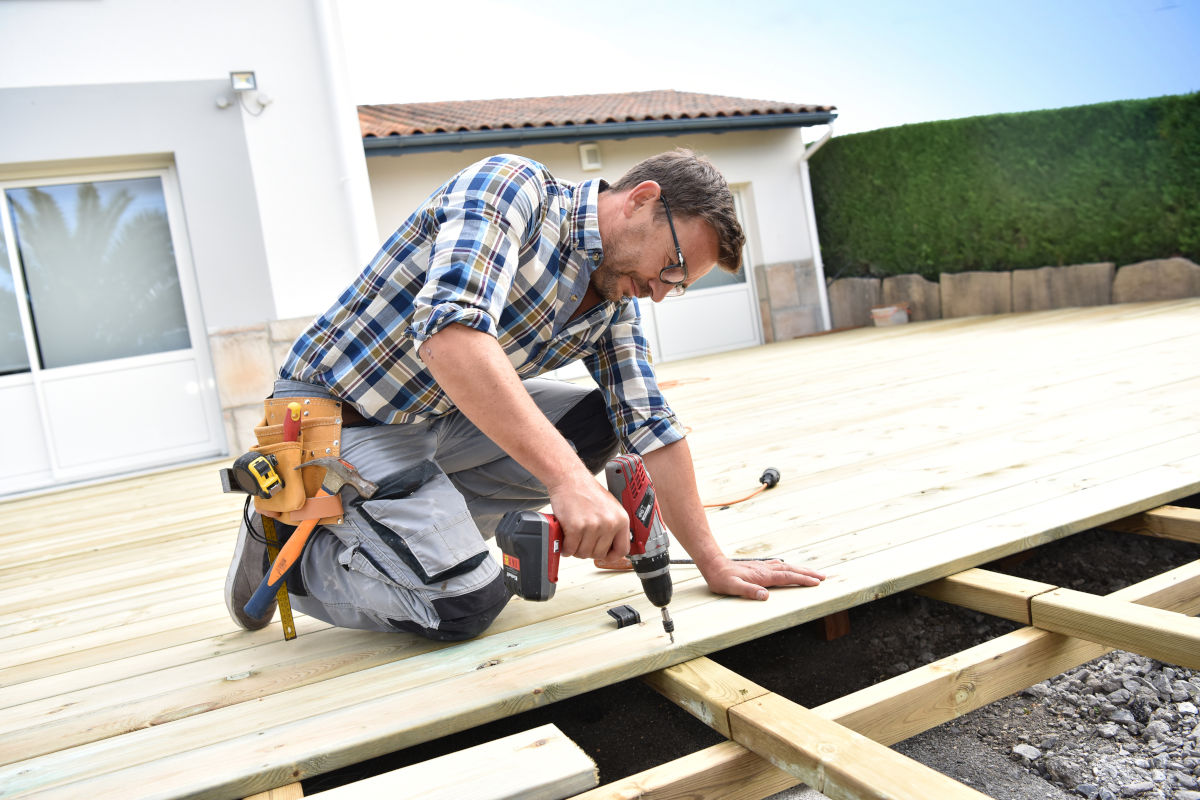Top 10 Decking Tools to Build a Deck

Building a deck in your backyard is an exciting DIY project. Whether you’re a DIY enthusiast or are new to home improvements, you will need the right decking tools to get the job done.
Decking is an ideal landscaping option for homeowners with large or small backyards. It creates a space for social events, alfresco dining and makes additional room for families to enjoy.
There are all kinds of tools available, from basic measuring equipment to more advanced power tools. If you’re not a complete beginner, you may have already acquired some of the instruments required to build a deck.
So, search your cupboards before heading to the local hardware store, and more importantly, read this guide! Here we discuss the top 10 decking tools to build a deck so that you can jump right into your decking project.
Basic Tool Categories
As there are many devices needed to install decking, it can be useful to establish some basic tool categories before you begin.
Firstly, tools can be divided into two major categories - power and hand tools. Hand tools are those which are used to perform a task by hand, while power tools require a power source to function.
After this, tool categories generally include;
- Layout and measuring
- General
- Cutting
- Fastening
- Smoothing
Designing and putting together decking materials is a relatively large job. There are tons of tools that could support you on the journey, but here are the top 10.
Top 10 Decking Tools to Build a Deck
Whichever decking materials you decide to go for, from pine, timber and cedar to composite decking, you can count on these essentials.
Measuring Tape
Every designer, craftsman and DIYer knows that getting the measurements right for a design is crucial. You should plan your project precisely with thorough attention to detail.
A 25-metre tape measure is a standard measuring device and can be used for most measurements. For bigger jobs, longer tapes are available. It’s a good idea to invest in a decent quality measuring tape to ensure durability and reduce the chances of breakage.
Level
Once the calculations are correct and the levelling is secured, the chalk liner comes in. A chalk liner is a tool that marks straight lines over long distances. It eradicates doubt ensuring all is perfectly straight.
A string line coated with chalk leaves straight markings between two points. This is the solution to drawing wonky lines with your own hand. You can then follow the markings as a guideline when it comes to cutting, trimming or moving decking material.
Shovel
The shovel is the dream gardening tool for all sorts of landscaping duties and general upkeep.
For building a deck, a shovel is required for shovelling the ground beneath where you want to put the deck. You will need to dig holes for the posts to sit securely in the ground. This will essentially create the perimeter of the deck.
Circular Saw
Saws are imperative for any woodwork project. There are lots of saws and you may use several throughout the construction process. The best option in this case is a circular saw capable of cutting various decking material, whether posts, joists or boards. The circular saw will work for the majority of cuts.
Depending on the size of your project, you should stock additional circular saw blades to switch over once worn.
Utility Knife
A utility knife is extremely handy to have in your toolkit or belt for any kind of manual work.There’s all sorts of scenarios where a knife can come in, like marking wood, opening packaging and making small cutting modifications.
Drill
Like the saw, you won’t get very far without a drill. Several drills can be used throughout the process, but your best bet is a good quality, cordless electric drill. This is the most-used kind to drill pilot holes in deck boards.
As it’s a power tool, make sure you’re equipped with the right set of batteries for longevity between charges.
Sander
A sander will ensure your deck is smooth and safe to walk on. Wood fibre can cause splinters and other uncomfortable injuries, but the sander will remove any sharp or rough edges.
A random orbital sander is an effective choice that sands the wood in a particular cyclical pattern. It will help to remove stains, and refinish the deck, bringing out the natural colour of the wood.
Sanding will get your decking boards looking their best.
Impact Driver
Whether constructing the sub-frame using batten screws, or attaching the decking boards using decking screws, an impact driver is your best friend. The impact drivers combination of screwing and hammering makes light work of construction your deck.
Clever Tool
Use a tool such as a clever tool to both pre-drill the decking boards to ensure they don't split and also to create a neat countersink in the wood ensuring that all your screws sit flush with the top of the decking board. Whilst decking screws ofter have a feature known as a self-embedding head, this will often "tear" the wood leaving a somewhat splintered finish around the screw. A deck is an expensive investment, so for the best finish use a clever tool to pre-drill and countersink your screws, especially if installing a hardwood deck.
Other Factors to Consider
Screws & Nails
While not considered tools, you won’t get anywhere fast without screws and nails. Whatever you’re creating, there’s a screw and nail type tailored to the project. There’s a range of wood and timber screws.
For decking, you’ll need a screw that is well-equipped for the elements where corrosion is a threat. Decking fixing screws and decking nails are specifically designed for the use of decking and other softwood outdoor structures.
Dome head decking nails and stainless steel deck screws are corrosion resistant and ideal for outside structures. If you want to attach timber to a steel framework, consider 12g 65mm decking screws and 35mm decking screws.
Safety & PPE
For any construction work, care should be taken for the health and safety of all involved. Everyday DIY tools can cause injuries and accidents, regardless of how much experience you have. If you’re going to build your own deck, you should take all the necessary precautions.
As well as ensuring you have the right tools, you should also consider your personal safety in terms of PPE. Generally, building a deck requires hearing protection, eye protection, and a pair of suitable gloves.
Council Approval
Whether or not you need to obtain building permission for a deck project in Australia depends on the state you are living in, regardless of how big or small your plans are.
It’s always sensible to check for council approval before diving into your decking project. You can clear up any confusion by calling your local council. Without the right approvals before you begin, you could end up having to rip out your new decking board.
Now, with our recommendations for the most important decking tools to use to build decks, you can create a plan and begin making the necessary arrangements. Remember to consider how a deck will fit in with your existing landscape features.
If you have to buy some or all of the tools listed here, consider them investments. These tools are good for a number of jobs in the home, without having to call a builder. Once in your possession, you can continue to practice and improve your DIY skills.
FAQs
What decking tools are required to build a deck?
To build a deck, there are many tools required. The most essential decking tools include a combination of power and hand tools, from a circular saw, power drill and impact driver to a shovel, utility knife and hammer.
What is the best saw for building a deck?
Several saws are useful in a deck building project. The most capable saw for handling most cutting jobs is the circular saw. A circular saw can cut through all kinds of materials, from timber to heavier construction materials like concrete.
Can a DIY beginner build a deck?
Building a deck can be a big project, but with the right tools and knowledge, a DIY beginner can succeed. Many people build a deck as a first home improvement project. It can be as simple or as difficult as you choose to make it.


